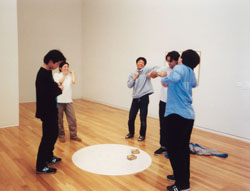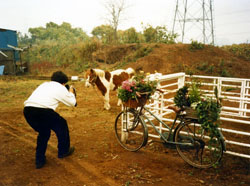Michihiro Shimabuku, Artist (Born 1967 in Kobe. Currently based in Berlin.)
Okabe: I have seen your works in the "Donai Yanen!" (1998) exhibition. Since when did you start to exhibit overseas?
Shimabuku: Well, I went to a university in San Francisco so I was never conscious about working in Japan or overseas. I just wanted to go somewhere I did not know and did not have to study sketching in order to enter an art university. I discovered that I could fulfill these conditions if I entered an American art school.

輪ゴムをくぐり抜ける
2001 東京オペラシティアートギャラリー
©Michihiro Simabuku
Okabe: But why San Francisco?
Shimabuku: I was interested in the cultures in San Francisco more than New York. I admired the hippie culture and the beatnik culture for their humane feelings. Also, after graduating high school, I was definite about going into art but I really wanted to do something in between art and writing. Which is kind of what I'm doing now but this kind of art is of a type you cannot study in Japan. After I entered an art university in San Francisco, however, my professor said "You don't have to come to school." That was said after only 6 months of university. I guess he knew that I was a kind of student who discovers and learns things best just by being around the town environment. After that, I went to London and shaved one eyebrow off.
眉毛の消去と出現 1991 ヨーロッパ
©Michihiro Simabuku
Okabe: Despite not going to school, they gave you 2 years worth of grades and you graduated from university. It was lucky for you to have such an understanding professor.
Shimabuku: That is because I was clear about what I wanted to do. I think there will always be understanding professors like that. I do not do things that I do not wish to do and I do not do things that I am told to do. I also do not want to prepare for exams just because I have to take a test. Those are things I try to avoid. I'm stubborn, I guess. I am the type of person that likes to make games starting from setting the rules. That is why I have rules for how to look at my work or having text with pictures. I'm interested in creating my own composition.

鹿をさがして
1997 アーカス,茨木
©Michihiro Simabuku
Okabe: You joined "The Gift of Hope" Exhibition that was held in the Museum of Contemporary Art Tokyo and also the "Encounter" Exhibition that was held in the Tokyo Opera City Art Gallery at the same time. What did you think of these concepts?
Shimabuku: They were all about people. For me, before saying anything about museums or anything else, it is more the curator's personality and working style that will reflect on and also influence my work. For instance, because Mr. Shioda from the Museum of Contemporary Art Tokyo is a son of a fish shop owner, I decided on a theme about Octopuses. I would ask him to take me to Tsukiji (the famous Japanese Fish Market) if he knew the place well, however, given that he is such a busy person, I did not think we will have a relationship in which we can share meals together often. For that reason, I decided to show a video. On the other hand, Tokyo Opera City's Ms. Kataoka was the kind of person who I can have meals with regularly. That is why I created an art work that requires me to be there every day. I think the personality and the preparation of the curator will be shown in my works. I guess my art work depends a lot on the director.
Okabe: Basically, curators are important since they are the people who will communicate during exhibitions and that is where it all starts. About the video work "In Search of Deer", did you attach the video camera to yourself? Are some of your other works are taken by someone else? Or does it depend on the work?
Shimabuku: It depends. However, I try not to ask professionals. I think it is best to ask lovers, as lovers will understand the most important element. My work is not that dramatic so I guess it is better to be taken more poorly.
Okabe: Is the feeling of not wanting to get nervous or not wanting to do something so professionally the same for when you paint?
Shimabuku: Yes. Doing a good job does not always mean the work is beautiful.
そしてタコに東京観光を贈ることにした
2001 東京都現代美術館
タコとタヌキー島袋野村芸術研究基金2001
オペラシティーアートギャラリー
©Michihiro Simabuku
Okabe: Did someone else make the white elephant for the Kitakyushu (Northern Kyushu) Municipal Museum of Art 6th Biennale (2001)?
Shimabuku: For that project, I did a lot of the work myself. What made me happy there is how the local storytellers made a story for the art piece. The museum was filled with middle aged people and my project was popular with those in their 40s, 50s and 60s. It was like a traditional Japanese vaudeville or a storytelling session. The feedback received was very good too. Modern art gives the impression that it is for the young so I wanted to create something for an older generation. I was very glad I could do that.
二度起こること - 象の話し
2001 北九州市立美術館
©Michihiro Simabuku
Okabe: I am guessing it is difficult to exhibit something like that in Northern Kyushu unless it is a biennale because of the problem of budget and organizations.
Shimabuku: It is not only Northern Kyushu though. Generally, people need to figure out working in more creative ways. For example, if you cannot exhibit inside, do it outside. Also, you can do without money. There are ways and techniques. What annoys me, though, is the fact that museums, both Japanese and overseas, use most of their budget on walls and shipping. I dislike it when they say "We do not pay artists any exhibition fees" for those reasons. I prefer them to suggest exhibitions without walls. Wall fees and insurance fees occur when you exhibit Picasso. I think it is silly that living artists also have to also pay them. Exhibitions starting " 1, 2, 3 Go!" are silly too. Raw food has a time of best flavor. Art pieces too, may only have one day of peak condition. If we are all too neat and orderly, our work will all become like frozen food.
Okabe: I believe the cost for creating an art work depends on the offer from museums and the relationships you have with them. How is the relationship between you and your gallery?
Shimabuku: Since I have been associated with the Air de Paris Gallery in France, I find it difficult to meet others that I am satisfied with. The staff in Air de Paris are very passionate about my work even when it does not sell well. While I think it is easier to sell there than in Japan, they never ask me to create anything that is easy to sell. Instead they are thrilled when I create something like "Passing through the Rubberband".
Okabe: So selling becomes art.
Shimabuku: Yes. They do things with that concept and so do I. That is why I empathize with them. They are not trying to copy the American system. They are trying to create their own system. I think being businesslike is silly. I believe we can have fun and also do business. My gallery knows how much money I have and I also know how much money they have. We are close enough to know each other well. That is why they know I'm short on money when I ask them to sell my pieces. They give me money anyway, even when they have not yet sold my work. I guess we try to support each other so that both are able to survive.
ニューヨークで 2000
©Michihiro Simabuku
(Interview held in the Kobe Art Village Centre, June 2001)
